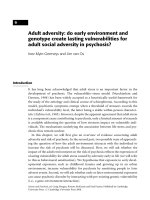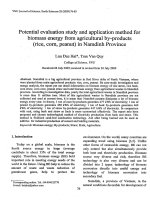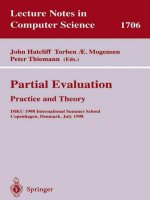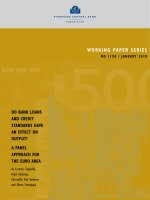Do evaluation periods and presentation modes matter
Bạn đang xem bản rút gọn của tài liệu. Xem và tải ngay bản đầy đủ của tài liệu tại đây (354.16 KB, 91 trang )
MYOPIC LOSS AVERSION:
DO EVALUATION PERIODS AND
PRESENTATION MODES MATTER?
LU XIAOYAN
NATIONAL UNIVERSITY OF SINGAPORE
2007
MYOPIC LOSS AVERSION:
DO EVALUATION PERIODS AND
PRESENTATION MODES MATTER?
LU XIAOYAN
(Department of Economics, NUS)
A THESIS SUBMITTED
FOR THE DEGREE OF MASTER OF SOCIAL SCIENCE
DEPARTMENT OF ECONOMICS
NATIONAL UNIVERSITY OF SINGAPORE
2007
Acknowledgments
I would like to first acknowledge my supervisor, Associate Professor Anthony T H
Chin, who has broadened my knowledge not only in the topic of this thesis but also
in future research work in general. He spent much time editing the earlier draft of
this dissertation. Without his effort, this thesis could not have been done.
I would also like to thank all my friends in Singapore. With their help, it would have
been possible for me to make it in my struggle on this small island for two years. I
am also indebted to the friends I have all around the world, giving me sympathy,
love and comfort. I draw such a lot of strength from them.
In particular, however, I owe a debt of gratitude to my father who has continuously
encouraged me to press on in my studies. Finally, I want to thank my mother, who
has been fighting a serious illness for almost a year. Every time I felt like giving up
while writing this thesis, her face would appear in my mind and all thoughts of
giving up would disappear. I wish she would recover now as I put the finishing
touches to this thesis.
i
TABLE OF CONTENTS
TABLE OF CONTENTS.............................................................................................ii
SUMMARY .................................................................................................................iv
LIST OF TABLES.......................................................................................................vi
LIST OF FIGURES ...................................................................................................vii
CHAPTER 1 .................................................................................................................1
Introduction...................................................................................................................1
1.1 Gambling and Attitudes to Risk ....................................................................1
1.2 Theoretical Background .................................................................................2
1.3 Objectives.........................................................................................................5
1.4 Overview ..........................................................................................................7
CHAPTER 2 .................................................................................................................8
The Impact of Myopia...................................................................................................8
2.1 Myopic Loss Aversion .....................................................................................8
2.2 Prospect Theory ............................................................................................ 11
2.2.1 A Probability Weighting Function.........................................................13
2.2.2 The Reflection Effect ............................................................................14
2.2.3 Loss Aversion........................................................................................16
2.2.4 Mental Accounting................................................................................18
2.3 The Impact of Myopia ..................................................................................20
2.3.1 Evaluation Periods ................................................................................21
2.3.1.1 The Model ...................................................................................................22
2.3.1.2 Gambling Variations of the Model ..............................................................27
2.3.2 Presentation Modes...............................................................................29
2.3.2.1 The Lottery Space .......................................................................................30
2.3.2.2 Differences in Aggregated and Segregated Evaluation ...............................32
2.3.2.3 The Case of Gambling with High Probability for Trivial Loss ...................34
2.3.2.4 Extension.....................................................................................................36
2.3.2.5 Probability Weighting..................................................................................38
CHAPTER 3 ...............................................................................................................40
Experimental Study .....................................................................................................40
ii
3.1 Study 1: Risk Taking and Evaluation Periods............................................40
3.1.1 Design and Procedure ...........................................................................40
3.1.1.1 Design..........................................................................................................40
3.1.1.2 Procedure.....................................................................................................44
3.1.2 Results of Study 1 .................................................................................46
3.2 Study 2: Repeated Gambling and Presentation Modes .............................51
3.2.1 Design of Study 2..................................................................................51
3.2.2 Results of Study 2 .................................................................................54
3.3 Concluding Remarks ....................................................................................57
CHAPTER 4 ...............................................................................................................60
Discussion and Conclusion ........................................................................................60
4.1 Practical Relevance.......................................................................................60
4.1.1 Gambling as a Worldwide Phenomenon ...............................................60
4.1.2 The Strategic Management of Gambling Machines .............................62
4.2 Conclusion .....................................................................................................64
APPENDIX A .............................................................................................................68
Experimental Instructions for Study 1 .......................................................................68
A.1 Introduction..................................................................................................68
A.1.1 Introduction for the Status quo Group .................................................68
A.1.2 Introduction for the Endowment Group...............................................69
A.2 Instructions for Part 1 .................................................................................70
A.2.1 Instructions for Part 1 in Treatment F ..................................................70
A.2.2 Instructions for Part 1 in Treatment I ...................................................73
A.3 Instructions for Part 2 .................................................................................75
A.3.1 Instructions for Part 2 in Treatment F ..................................................75
A.3.2 Instructions for Part 2 in Treatment I ...................................................76
APPENDIX B .............................................................................................................77
Questionnaire for Study 2 ...........................................................................................77
BIBLIOGRAPHY ......................................................................................................79
iii
SUMMARY
This study has employed principles of behavioral economics, primarily that of
Myopic Loss Aversion (MLA), in an attempt to understand the gambling behavior of
individuals playing slot machines and to perhaps shape regulation towards excessive
behaviour or addiction.
Individuals are often myopic in evaluating sequences and gambling opportunities. A
decision-maker with loss aversion exhibits preference reversal, that is, the
acceptance of a series of the same gambling game that would otherwise have been
rejected if asked to bet once. It has been suggested that this reversal is caused by
myopia. The literature suggests that both the Evaluation Period (EP) and the
Presentation Mode (PM) matter, and that they are due to myopia. Both a longer EP
and an aggregated PM increase the attractiveness of a series of bets. In this study, we
argue that the relationship between a longer EP and an aggregated PM may not be
generalized as suggested by earlier works, for it depends on specific parameters of
the bets. We introduce the concept of MLA and specifically analyze the causal
mechanisms through which EP and PM affect the decision-maker gambling with a
high probability of trivial losses, for example, slot machines or ‘one-arm bandit’
machines.
The theoretical analysis predicts that as more returns are evaluated frequently, the
iv
more risk aversion individuals will have, resulting in a lower acceptance rate once
the overall distribution is displayed. Thus, a longer EP cannot be treated the same as
an aggregated PM for this type of bet. The theoretical postulations are supported by
experimental evidence.
All slot machines have odds with a high probability for trivial losses. While the
losses may be small, they do add up quite a bit. In many private clubs, contributions
from slot machines form a sizeable source of revenue. The impending
Casino-cum-Integrated Resorts at Sentosa and Marina Bay will no doubt increase
accessibility to “small gambling” and we need to study closely this type of gambling
behavior. The way information is provided and processed can have a strong
influence on choice.
v
LIST OF TABLES
Table I: Experiment Design of Study 1
41
Table II: Data Summary of Study 1
48
Table III: Regression Results
50
Table IV: The 2×3 Design of Study 2
52
Table V: Acceptance Rate of Gambling Games
54
Table VI: Summary of Hypotheses
66
vi
LIST OF FIGURES
Figure 1: A Probability Weighting Function
13
Figure 2: A Hypothetical Value Function
14
Figure 3: Utility of Gains and Losses
25
Figure 4: The Lottery Space ℜ150
Erreur ! Signet non défini.
Figure 5: Iso-D Lines in the Lottery Space ℜ150
Figure 6: Iso-D lines in the Lottery Space
ℜ150 for Gambles with High
Probability for Trivial Loss
Figure 7: DG (l ) for k = 2.25
Figure 8:
34
35
and α = β = 0.88
37
ℜ150 with Iso-D lines for gambles with High Probability for Trivial
Loss for
k = 2.25 and α = β = 0.88
38
Figure 9: Comparing Betting Patterns
47
Figure 10: Rational Choice Mechanism
63
vii
CHAPTER 1
Introduction
1.1 Gambling and Attitudes to Risk
Is the acceptance of a single play of a game of chance the same as the acceptance of
repeated plays of the same game? We make many such decisions in our daily lives,
i.e. discrete choice (one-time purchase of a bottle of vodka) versus continuous choice
(how frequent we consume the vodka). While the occasional glass of vodka is
negligible, a lifetime of frequent consumption on a daily and weekly basis will lead
to a negative impact on health. The choice to smoke an occasional cigarette or cigar
in a pub is different from addiction to nicotine. Not putting the seatbelt on a single
trip to the supermarket is not as risky as consistently not putting on a seatbelt for
every trip. The individual who goes to the casino to gamble as an entertainment
activity and is in control of his actions is on safe ground, but one who needs to
gamble is the individual we should be concerned about. Betting is gambling no
matter how big or small the amount bet! The issue seems that many people are
motivated by risk loving considerations and are willing to sacrifice pecuniary gains
to the out-of-control level, but is this possible if individuals are making decisions
under the strain of gambling?
Previous studies have focused on repeated decisions that are identically distributed
1
and draw reference from the frequently quoted example by Samuelson (1963), in
which a colleague decided to reject a simple bet with a fair chance of winning $200
or losing $100, but was willing to accept a series of 100 such bets. Samuelson made
an induction statement to prove an inconsistency theorem, which asserts that
assuming his colleague was a utility maximiser, he should have refused the
opportunity of a series of bets if he had refused a single bet. In other words, no
utility function can demonstrate this inconsistent behaviour. This has led to a series
of works on repeated gambling followed by normative analyses of risk aversion
within an Expected Utility framework. Works by Lopes (1981), Tversky and
Bar-Hille (1983), and Shoemaker and Hershey (1996) suggest a failure of Expected
Utility Theory to explain the phenomenon. Other studies (Lippman & Mamer, 1988;
Nielsen, 1985; Ross, 1999) show that the Expected Utility maximiser may end up
making a choice similar to that of Samuelson’s colleague and that risk attitude alone
is sufficient to explain this behaviour.
1.2 Theoretical Background
A second stream of literature, central to this thesis, analyzes the phenomenon from
an experimental perspective. Benartzi and Thaler (1995) introduced the term,
Myopic Loss Aversion (MLA), to explain preference reversal. Individuals faced with
multiple plays of a game of chance decline the opportunity to play a single game
owing to reverse preferences when shown a distribution of the same game. MLA
2
combines two aspects of behavioral theory, that of “loss aversion” and “mental
accounting”, to explain the phenomenon. Loss aversion (Allais, 1979; Benartzi &
Thaler, 1995; Kahneman & Tversky, 1979; Kahneman & Tversky, 1992) occurs
when individuals weigh losses greater than gains. Mental accounting (Thaler, 1985)
describes the dynamic aggregation rules that individuals follow to code and evaluate
risky outcomes. The MLA concept was introduced to explain the equity premium
puzzle 1. It has been suggested that the volatile return of a stock investment looks
considerably unattractive in a myopic evaluation 2 . Therefore, longer-horizon
investors should tolerate more risks because they can more easily diversify risks over
time by recouping intermediary losses with future chances of winning (Gollier,
1996).
Thaler et al. (1997) and Gneezy and Potters (1997) provided explicit tests of the
interdependence between the evaluation period and risk-taking behavior through
experimental studies. By manipulating the evaluation period of the subjects’
sequencing of mixed gambling, a significant impact on acceptance was observed as
proposed by MLA. Gneezy, Kapteyn and Potters (2003) confirmed MLA in an
experimental competitive environment. When a shorter evaluation period was
induced, observed equilibrium prices for the assets were lower. Haigh and List (2005)
found that professional traders exhibit behavior consistent with MLA to a larger
1
This was a term coined by Mehra and Prescott in 1985, and it is based on the observation that individuals are
more willing to hold government bonds than stocks with a much higher return.
2
In the studies of investment decisions, employees are presented with the characteristics of 1-year return
distributions, and then the simulated distributions of 3-year returns. The 1-year return is deemed as myopic
evaluation.
3
extent than students.
Benartzi and Thaler (1999) confirmed the relationship between the degree of myopia
and the presentation mode i.e. if an explicit distribution of repeated plays is given,
subjects are more willing to accept multiple plays. This finding is typical of
Kahneman and Lovallo’s (1993) argument that individuals tend to consider problems
as unique rather than aggregate them into a portfolio, which they call “narrow
framing” 3 . Redelmeier and Tversky (1992) explicitly tested the influence of
presentation modes on the attractiveness of multiple plays, and showed that
individuals tend to segregate multiple prospects, isolating each prospect from a
larger ensemble. They have suggested that the tendency to segregate prospects
depends on the representation of the problem. The concern regarding the
attractiveness of the aggregated presentation mode has since been consistently
raised.
However, Langer and Weber (2001) looked at a specific type of lottery with a low
probability for high losses and found that an aggregated presentation mode for this
type of lottery could decrease the players’ willingness to accept prospects, which
means that an aggregated evaluation could have either a positive or a negative effect
on them depending on the specific parameters, and that the above phenomenon is not
as straightforward as the literature suggests. Langer and Weber (2005) extended
3
The concept of framing is important in mental accounting analysis. In framing, individuals alter their
perspectives according to the surrounding circumstances that they face (Pompian, 2006). Narrow framing means
considering gambling activities or investments one at a time rather than aggregating them into a portfolio.
4
MLA to Myopic Prospect Theory to incorporate general cases in any economic
scenario. Pure loss aversion does not fully capture the empirically observed attitude
towards risk. With diminishing sensitivity in both domains of gain and loss, myopia
does not decrease the attractiveness of a lottery sequence in general.
1.3 Objectives
As indicated above, most studies attempt to explain the impact of myopia. All have
indicated that the effects of a long evaluation period are similar to that of an
aggregated presentation mode, which means that either a longer evaluation period or
an aggregated presentation mode would lead to a riskier choice being made more
attractive, i.e., a shorter evaluation period and a segregated presentation mode would
reduce the acceptance of repeated plays. However, do these two factors always affect
decision-makers in the same way?
The current research aims to advance our understanding of MLA in gambling that
has a high probability of trivial losses but which, in aggregate, could lead to a sizable
amount of losses over time. Evaluation periods and presentation modes are two
significant factors in MLA, and the player’s decision is a result of interplay cased by
them. However, they may not simultaneously affect the weight the players attach to
losses, which depends on several “special” parameters. To gain a closer
understanding of MLA in this type of gambling, we look at different mechanisms of
5
the evaluation period and the presentation mode and assess their impact on
decisions.
We address gambling with a high probability for trivial losses because of its
worldwide popularity with large numbers of gamblers, who are increasingly
spending much time and money on slot machines 4. Most of them lose money, and
although they resolve not to play again, they are usually not able to keep their
resolution as these machines are easily accessible and inexpensive to play. Gambling
games become more attractive when presented in a segregated mode. In some
amusement arcades, it is required by law that gambling machines should be turned
off automatically after an hour of continuous gambling (Traub, 1999) and
exchanging credits or monies with machines or in any form strictly prohibited
(Blaszczynski, Sharpe, & Walker, 2003; Turner & Horbay, 2004). One reasonable
explanation for such mandatory measures is that people in the midst of playing slot
machines often suspend judgment and produce infrequent assessment of financial
losses. Consequently, we observe that given a longer evaluation period, individuals
may put more money into gambling machines. In this example, a long evaluation
period and an aggregated presentation mode influence the decision-maker in
opposite directions. The former makes people more risk-loving in playing slot
machines, but the latter increase aversion to such gambling games.
4
Slot machines generally have three or more reels displaying symbols such as lemons, cherries, lucky sevens
and diamonds (Dickerson, 1996; Turner & Horbay, 2004).
6
To proceed towards a more complete understanding of the conditions under which
aggregated presentation modes and frequent evaluation periods decrease a gambler’s
willingness to accept multiple prospects of gambling with a high probability for
trivial losses, it is vital to gain a deeper perception into the nature of the underlying
causal mechanisms. The key research question addressed in this thesis is: What are
the causal mechanisms through which the evaluation period and the presentation
mode affect decision-makers’ weight they attach to losses when they play gambling
games with a high probability for trivial losses? We investigate this question by
employing and adapting two experimental methods introduced by Benartzi and
Thaler (1995) and Gneezy and Potters (1997). The answer to this question has
significant implications for understanding gambling behavior.
1.4 Overview
The remainder of this study is structured as follows. Chapter 2 gives a brief
background of MLA, followed by a theoretical analysis to address the specific type
of gambling, and defines different mechanisms through which the evaluation period
and the presentation mode work. Chapter 3 presents research hypotheses and reports
the results of experimental studies. Chapter 4 presents the practical relevance of this
study and concludes with a short discussion on the usefulness of the study.
7
CHAPTER 2
The Impact of Myopia
2.1 Myopic Loss Aversion
Myopic Loss Aversion (MLA) is an aspect of behavioral theory that combines loss
aversion and mental accounting. Benartzi and Thaler (1995) use this term to describe
the preference reversal of a decision-maker contemplating a single game of chance
versus repeated plays of that game. When evaluating multiple plays of a simple
game of chance, say a fair chance to win x or lose y 5 , individuals show
sensitivity to the amount y that can be lost with a one-time play. If the distribution
of returns for the portfolio is held constant, gamblers are more likely to increase the
acceptance of repeated plays; that is, intuitively, they display MLA, excessively
concerned about short-term losses.
The interplay between a single play and repeated plays of gambling games has
fascinated individuals since Samuelson’s observation (1963). A colleague was
offered a chance to win $200 if the flip of a coin yielded heads and a loss of $100 if
the coin did not yield heads. The colleague declined this single game of chance, but
at the same time expressed a willingness to accept a series of 100 such games.
Samuelson termed the fallacy of large numbers to describe this inconsistent choice,
5
x
and
y
respectively denote the amount of money to win and to lose.
8
which asserts that if this colleague would reject a single play at the level of wealth
obtained from playing 99 times already, he should not then accept multiple plays of
the same game. Applying backward induction, the colleague should reject playing
the first game of the multiple plays from the very beginning. Samuelson concluded
that his colleague’s behavior was irrational within the Expected Utility framework.
Nielsen (1985) , Lippman & Mamer (1988), Ross (1999) and Aloysius (1999) have
shown that risk aversion alone can adequately explain the phenomenon of refusing a
single bet while accepting a series of independent bets6. Experimental methods offer
a different perspective 7 . Experimental models build upon the complexity of
individuals’ decisions which maximizing expected utility cannot explain 8. While
many studies (Edwards, 1954; Markowitz, 1952) emphasize the fact that individuals
tend to perceive and evaluate change of wealth rather than final wealth, this has been
made clearer with the introduction of Prospect Theory 9 (Kahneman & Tversky,
1979). Employing the central concepts of Prospect Theory and extensions, Benartzi
and Thaler (1995) have proposed a new concept, MLA, to explain the behavior of
Samuelson’s colleague.
Benartzi and Thaler consider a decision-maker with a value function of the form:
6
For a detailed survey, see Ross (1999).
Theories of choice under uncertainty are broadly categorized as normative and descriptive. Normative theories
are based on the notion that preferences should in some sense be consistent across different choice problems,
which are typically presented in an axiomatic form. Expected Utility is the most prominent normative theory of
choice under uncertainty, proposed by von Neumann and Morgenstern in 1944.
8
The most fundamental criticisms were made in the early 1950s by Allais. “Allais paradox” induced even
staunch advocates of Expected Utility.
9
Details would be discussed at a later part of this chapter.
7
9
⎧ x,
v( x) = ⎨
⎩2.5( x),
if x ≥ 0
,
if x < 0
⑴
where x is a change in wealth relative to the current status. This function means
that gains are treated differently from losses at the reference point, e.g. current
wealth. Adapting Kahneman and Tversky’s (1979) Prospect Theory, there is a
tendency by individuals to weigh value losses 2.5 times more than gains.
Drawing from Samuelson’s original gambling game as an illustration, the above
function can be illustrated as follows:
⎧0.5
S ⎨
⎩0.5
$200
- $100.
The above illustration would be rejected by Samuelson’s colleague since a loss
outweighs the higher gain ( 0.5 × 200 + 2.5 × 0.5 × (−100) < 0 ). However, if he were
faced with a succession of two independent draws of S, his decision would depend
on the “bracketing of the problem” (Read, Loewenstein, & Rabin, 1999). Given his
myopia, he should evaluate and dislike each of the games. However, if he were to
perceive the games in aggregate:
S+S
⎧0.25 $400
⎪
$100
⎨0.5
⎪0.25 - $200,
⎩
the overall distribution might become acceptable ( 0.25 × 400 + 0.5 × 100 + 2.5 × 0.25 ×
(−200) >0). Therefore, the gambling game becomes more attractive through
repetition of the single game evaluated in aggregate.
10
Benartzi and Thaler describe mental accounting as the dynamic aggregation rules
that individuals follow and propose that the attractiveness of the gambling game
depends on the evaluation period of the game. Individuals are averse to losses at an
irrationally short horizon due to the behavioral bias that they are too anxious to
evaluate on a short-term basis. Gollier (1996) analyzes the effects of the existence of
options for gambling in the future and attempts to ascertain an optimal dynamic
strategy towards repeated gambling. An undesirable gambling game can be made
desirable by offering the opportunity to replay the same game 10.
2.2 Prospect Theory
Life is full of uncertainty and unknowns, and individuals have to function within
such a context and make decisions all the time. There is much work being done on
making judgment and choice under uncertainty. Standard economic theory of choice
under uncertainty differs from other disciplines in its treatment of normative and
experimental models of behavior, that is, models that attempt to predict and explain
the role of rationality in human behavior. Normative theories are based on the notion
that preferences should in some sense be consistent across different choice sets,
which are typically presented in an axiomatic form. Normative theories assume that
human behavior is rational self-interested. A rational Expected Utility maximizer
epitomizes the typical decision-maker (von Neumann and Morgenstern 1944).
Expected Utility Theory (EUT) has since dominated analysis of choice under
10
The gambling games are independent and identically distributed.
11
uncertainty, but it is not without critics.
The most fundamental criticisms were made in the early 1950s by Allais. “Allais
paradox” 11 suggests that subjects tend to systematically violate the axiom of EUT.
Numerous experiments have been designed to test the empirical validity of EUT. The
experiments suggest that the predictions of EUT have been violated in various ways
subject to a wide range of experimental violations. Experimental models are
motivated by the desire to understand these “paradoxes” or “choice anomalies”. The
distinction between normative and experimental theory is not as clear-cut as it seems.
The majority of experimental models essentially retain certain valuable properties of
EUT. Prospect Theory (PT) (Kahneman & Tversky, 1979; 1992) is fundamentally a
modification of EUT and differs on a very basic assumption, which explains some
anomalies of EUT (Camerer & Thaler, 1995) by three elements: nonlinear weighting
of probabilities (departing from the linear weighing as in EUT), reflection effects
(outcome are evaluated not in absolute term, but rather compared with a reference
point), and loss-aversion (losses compared with the reference point loom larger than
gains). Moreover. There are two phases in the decision problem. In the first phase,
the problem is “edited” in a certain frame (narrow or broad). Second, maximizing
prospective value function the agent takes his decision. Usually, people called first
phase as mental accounting.
11
See the details in the discussion in Allais (1979) and Slovic & Tversky (1974).
12
2.2.1 A Probability Weighting Function
In a typical EUT setting, gambling that yields risky outcomes xi with probability
pi is valued according to ∑ pi u ( xi ) , where u ( x ) is utility function. In PT, it is
valued by ∑ π ( pi ) v( xi − r ) , where π ( p ) is weight function. The weight function
π ( p ) maps stated probabilities to decision weights nonlinearly, but in reverse
S-shaped (see Figure1).
1.00
Perceived Probability
0.75
0.50
Weighting Function
0.25
0.00
0.00
0.25
0.50
0.75
1.00
Actual Probability
Figure 1: A Probability Weighting Function
This shape of line demonstrates probability misperception. Low probabilities are
over-weighted and high probabilities are under-weighted. Subsequent works
(Kahneman & Tversky, 1992; Luce & Fishburn, 1991) replaced weights on
individual probabilities by a transformation of the cumulative distribution function.
13
2.2.2 The Reflection Effect
The main assertion was the claim that “the carriers of value or utility are changes of
wealth, rather than final asset positions that include current wealth” ((Kahneman &
Tversky, 1979, p.273). Hence, the value function v( x − r ) “should be treated as a
function in two arguments: the asset position that serves as the reference point, and
the magnitude of the change (positive or negative) from that reference point” (see
Figure 2).
VALUE
LOSSES
r
GAINS
Figure 2: A Hypothetical Value Function
(Source from Kahneman & Tversky (1979) Figure 3)
The value function also exhibits loss-aversion which means the effect of losses
outweighs gains in the equal-sized value. Kahneman and Tversky (1979, 1992)
proposed the following functional form for the value function:
14
⎧⎪ xα
v( x) = ⎨
⎪⎩− λ (− x )β
if x ≥ 0
if x < 0
⑵
where λ ≥ 1 is the degree of loss-aversion and α , β ≤ 1 measures the degree of
diminishing sensitivity. Kahneman and Tversky (1992) estimated λ to be 2.25 as
the median values, and
x
is the change from the reference point.
The value function in PT is generally concave in the domain of gains and generally
convex in the domain of losses. This attribute of the value functions is called the
reflection effect around the reference point (Kahneman & Tversky, 1979), which
postulates that the risk aversion exhibited by choices when outcomes are gains will
be transformed into a preference for risk when outcomes are losses. Accordingly, the
value function has to be concave above the reference point ∂ 2v( x) / ∂x 2 < 0 for
x > 0 , and convex below ∂ 2v( x) / ∂x 2 > 0 for x < 0 . Kahneman and Tversky (1979,
1992) regard this value function as having the feature of diminishing sensitivity
because of concavity in gains and convexity in losses, which implies that the
marginal utility of gains and losses decreases with their absolute size. Evaluating
changes is not independent of the reference level.
Suppose there is a decision-maker contemplating a gambling game that has a
probability of p to win x and a probability of q to lose y , he or she will
evaluate the prospects and make a decision as to whether to play it or not. The
overall value is obtained by the equation
V ( x, p; y, q) = π ( p )v( x) + π (q )v( y )
⑶
15
where, either p + q < 1 or p + q = 1 , the probability weighting function denotes
π (0) = 0 and π (1) = 1 , and the value function denotes v(r ) = 0 12.
It has been shown that if individuals do not accept a fair game (a,0.5;−a,0.5) , their
aversion to symmetric bets will increase with an increasing size of the stake (Heren,
1997; Tversky & Simonson, 1993). Now consider x > y ≥ 0 , according to the
equation,
we
should
have
v( y ) + v( − y ) > v( x) + v( − x)
or
v(− y ) − v(− x) > v( x) − v( y ) . When y = r , we obtain v( x) < −v(− x) . Hence, the
value function has to be steeper for losses than for gains, which is called Loss
Aversion (Kahneman & Tversky, 1979).
2.2.3 Loss Aversion
Loss Aversion refers to losses being weighed higher than equivalent gains at the
reference point, which is generally the current level of wealth. Individuals respond
differently to losses from gains. They overvalue losses relative to comparable gains.
Both experimental and empirical evidence clearly certifies the asymmetry in an
individual’s evaluation of losses and gains.
Kahneman and Tversky’s (1979) strong experimental evidence for Loss Aversion
uses hypothetical payoffs, which raises the problem of whether loss aversion will
12
r
denotes reference point, which is current wealth here.
16









